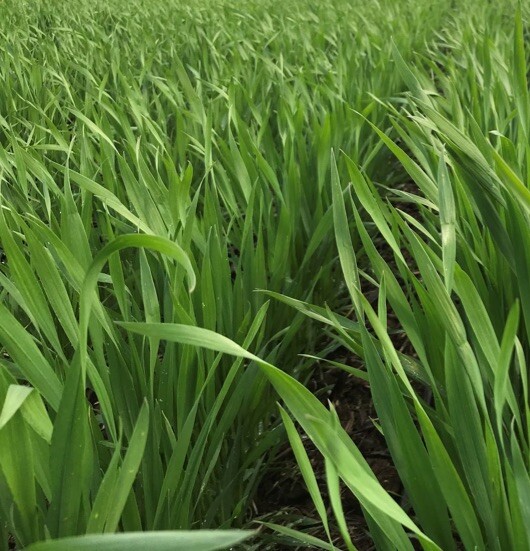Making the most of dual purpose crops
How to use grazing crops to minimise risk and maximise return.

Key messages
- Dual purpose winter crops can help fill the autumn–winter feed gap
- While there is currently a full moisture profile, a dry topsoil and potentially dry autumn may impact establishment
- Be mindful of soil temperature and available soil moisture when sowing early (February–March)
Dual purpose crops can be a great risk management tool because of their potential to increase crop returns and system benefits by filling critical feed gaps, resting pastures and providing a range of options in dry seasons.
Currently, soil moisture profiles are full across the Riverine Plains (below the topsoil) and mixed farmers may be thinking about sowing dual purpose crops at the earliest opportunity.
But what are the key things to think about, especially if you've never grown a dual purpose crop before?
Moisture
The benefits of early feed need to be balanced with the risk of sowing into dry, warm or weedy soils. While there is currently full moisture below 20-30cm depth, there needs to be enough surface moisture to germinate seeds and sustain plants until roots can access moisture below the surface.
Farmers wanting to capitalise on early autumn rainfall to establish dual purpose crops should carefully consider their paddock selection, choosing paddocks with manageable weed burdens and stubble loads. They will need to be on top of summer weed control and be prepared to sow quickly when an opportunity arises, bearing in mind a recent Bureau of Meteorology forecast which suggests the first sowing window will likely occur in second half of March and that April will likely be unusually dry.
The feed gap
Identifying the feed gap will help determine which dual-purpose crop is best for your system. Factors to consider are; will feed be needed early in the season or in winter? How much dry matter will the crop produce and what quality should I target for my class of livestock? Is hay, silage or grain production a target?
Some varieties produce good quantities of early fodder for grazing, some make good quality hay and silage, some produce high grain yields and some do all these; understanding the characteristics of a variety will help achieve the best result.
Sowing
Grazing cereals can be sown as early as late February to early March, however high soil temperatures may affect establishment.
If soil temperature is above 20–25 °C, poor germination (10–50%) may occur due to coleoptile shortening in cereals. Shallow sowing can compensate but may expose the seed to desiccation. High temperatures during establishment can also cause seedling mortality.
Weather damaged seed from the 2022 harvest should not be used when conditions are less than ideal, including in hot soils, waterlogged soils, where soil constraints are present, or in marginal moisture. Before planting, always conduct a germination and vigour test and adjust seeding rates accordingly.
Generally, a higher seeding rate will shorten the time to the first grazing. For an April–May sowing, target higher rates of cereal seed if the crop is dual purpose. Earlier-sown crops (February–March) can be sown at lower rates because of their longer tillering period.
Apply nitrogen up front and after grazing to assist early biomass production and yield recovery but consider the risk of livestock nitrate poisoning.
Maturity
Always select a variety based on when you want the crop to flower. This will maximise yield potential, whether crops are grazed or not, and provides alternative options if grazing becomes unfeasible.
Cereal varieties with a cold (vernalisation) requirement are ideal for very early sowing (February–March) because they can produce large amounts of dry matter and won’t head too early. Take care when choosing late–very late varieties as they may be filling at high temperatures or under moisture stress, and irrigation may be required to help reach maturity.
Consider that not all long season varieties have winter habit, so may still run to head if sown too early. Slower developing spring varieties are not suited to pre-April 20 sowing.
Many grazing canolas have a vernalisation requirement which causes them to flower later that the grain-only types. Choose winter canola types for March sowings and spring hybrid types from mid-April.
Grazing
Grazing can start once plants are well-anchored. For cereals, this is usually around the three-leaf stage, but grazing is often delayed until the five to six leaf stage when there is around 1.5 t/ha biomass. For canola, grazing can usually start at the six to eight leaf stage.
Before grazing, ensure pesticides (including seed dressings, insecticides and herbicides) are not within their chemical withholding periods.
Remove stock before the start of stem elongation (GS30) in cereals and bud elongation in canola to protect hay or grain yield.
Set stocking is likely to maximise animal productivity compared to rotational grazing. This is because the rumen take time to adjust to a new diet, so livestock will generally do better if grazed for longer on a crop. However, set stocking may complicate nitrogen topdressing given the three-week interval required between application and grazing to avoid nitrate poisoning.
Livestock health
While young crops are a great source of energy and protein (with energy levels (ME) ranging from 8 -14 (MJME/kg DM), protein (CP) 14-32% and dry matter (DM) ranging from 15 – 32%), they are low in fibre.
When grazing young, lush forage crops, ensure livestock transition slowly to the new diet and have access to enough roughage to avoid digestive and nutrient imbalances. Also consider the risk of nitrate poisoning and other animal health disorders.
For some of the animal health implications of grazing winter crops, see our blog Grazing forage crops - things to look out for.
If growing dual purpose crops for the first time, always seek good agronomic and animal health advice.
Sources & further reading
Author
NEWS
Keep up to date with the latest news from across the Riverine Plains.
-
Livestock
-
People
-
Grains
-
Sustainability

